Please Take Note: This is a review of the final game, but it might change slightly based on the success of the Kickstarter campaign. The game is being reviewed on the components and the rules provided with the understanding that “what you see is not what you might get” when the game is published. If you like what you read and want to learn more, we encourage you to visit the game’s web page or visit the Kickstarter campaign. Now that we have all that disclaimer junk out of the way, on with the review!
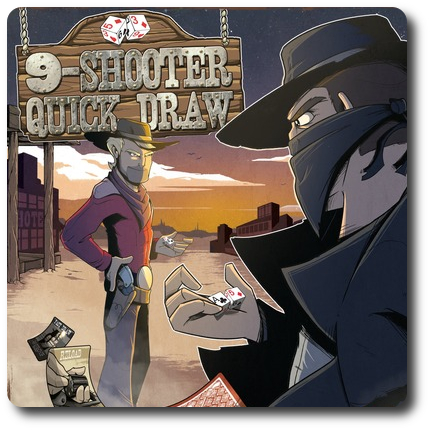
The Basics:
- For ages 5 and up (publisher suggests 8+)
- For 2 to 4 players
- Variable game play length
Geek Skills:
- Active Listening & Communication
- Counting & Math
- Logical & Critical Decision Making
- Reading
- Pattern/Color Matching
- Cooperative & Team Play
- Hand/Resource Management
- Reflex & Speed
Learning Curve:
- Child – Easy
- Adult – Easy
Theme & Narrative:
- Challenge your opponent to see who is the fastest dice chucker in the West!
Endorsements:
- Gamer Geek rejected!
- Parent Geek approved!
- Child Geek approved!
Overview
The desert sun beats down on you with intense heat, but that’s not why you’re sweating. No less than 50 yards in front of you stands your adversary. Through narrow gulches and dry stream beds, you have chased each other for what feels like a lifetime. Now, in this sleepy border town, the chase will end. One of you will live to see tomorrow, while the other will be in the cemetery before nightfall. Flexing your fingers and taking a deep breath, you prepare for what is to come and what might or might not follow.
9-Shooter Quick Draw, designed by Ryan Strong and to be published by Heartland Consumer Products, LLC, will reportedly be comprised of 18 Square Shooter dice, 16 Cowboy Showdown cards, 32 Shooter Action cards, and 30 Wound tokens. As this is a review of a prepublished game, we will not comment on the game component quality of the prototype we were provided. The proposed artwork by Brett Brooks (II) looks wonderful and the Square Shooter dice, if they are to be the same we were provided, are excellent (whoops, just commented on the component quality). Not included with the game, and only necessary if you play a specific game variant, is a timer to count down from 60 seconds.
Quick Component Roundup
There are very few game components for 9-Shooter Quick Draw, but knowing what each one is and how they are used is essential to the game play and the fun. Listed here is a brief summary of the game components.
Square Shooter Dice
The game comes with 18 Square Shooter dice, which is actually 2 complete sets of 9. Each set represents a full deck of cards. All of your clubs (♣), diamonds (♦), hearts (♥) and spades (♠) are found, including 2 Jokers. Note that there is no way to determine which die belongs to which set. Players can quickly divide the dice into sets by organizing them so each player has the Ace and King of spades, the Ace and King of hearts, the Ace and King of clubs, the Ace and King of diamonds, and 1 black Joker showing (see below image). With these 9 dice, the player has every card in a complete deck.
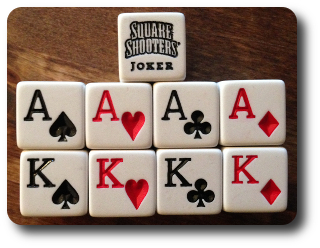
Cowboy Showdown Cards
These cards represent the gunslingers who have an itchy trigger finger and a hankering to scratch it. On the side of each card is a Poker hand comprised of 5 values and their accompanying suits. When these rough and tough gunslingers start taking damage, the Wound tokens are placed on the card to represent bullets that found their mark. Wound tokens can also be used to cover up certain values to let the player know that they have already been matched. Additionally, some Cowboy Showdown cards have a steer skull indicating the gunslinger is a “bad guy” or a star indicating the gunslinger is a “good guy”. The stars and skulls are always worked into the card’s illustration and never in the same place. For example, “The Masked Man” has a skull in the card’s title and “Cocky Pete” has a star on the character’s belt. See if you can find “Maw’s” affiliation symbol.
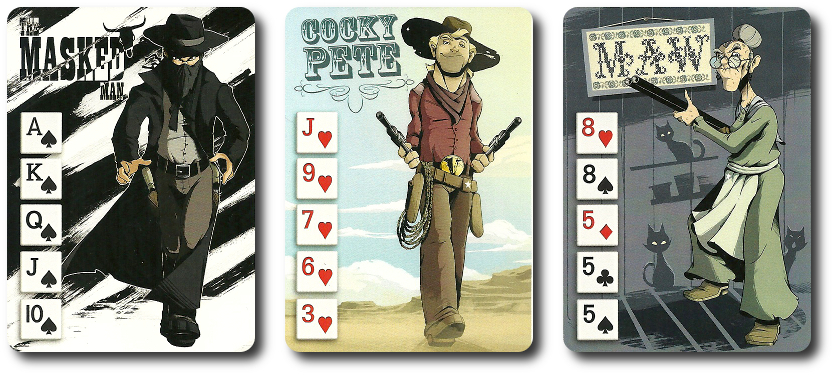
Shooter Action Cards
As if being stuck in the middle of a gunfight wasn’t bad enough, these card allow players to throw the proverbial monkey wrench into the works. Each Shooter Action card has 1 or 2 actions that can be used by the player during the game. Included with each action is the label “Quick Draw” and “Ambush”. The label identifies which game variant the action can be used in.
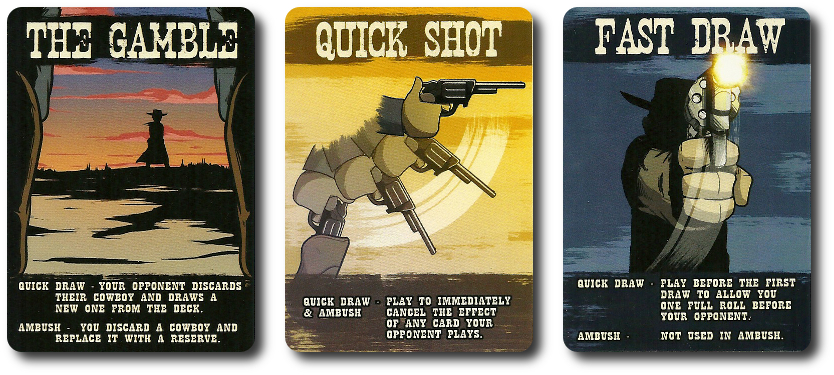
Two Games in One
9-Shooter Quick Draw is not just one game, but two, with a good number of game variants to spice things ups. Each of the 2 ways to play the game and the game variants are summarized in this review, but I’m going to skip the traditional summary of the game set up to focus only on the different games. I can easily summarize each game set up as follows:
- Give each player 1 set of 9 Square Shooter Dice
- Shuffle and deal cards
It’s an extreme simplification, but it’s not much more difficult than that.
9-Shooter Quick Draw
9-Shooter Quick Draw is a speed battle between 2 players that demands concentration, a keen eye, and lucky dice rolls. Each player gets 3 Cowboy Showdown cards, 3 Shooter Action cards, and 1 set of Square Shooter Dice. Players have an opportunity to look at their Shooter Action cards to familiarize themselves with the actions they provide. Then each player selects 1 of their 3 Cowboy Showdown cards and places it face-down in front of them. The remaining 2 Cowboy Showdown cards are set to one side, face-down. Both players reveal their selected Cowboy Showdown card and the fun begins.
One player shouts “Draw!” and both players pick up their 9 Shooter dice and roll them. After each roll, the player can do one of the following with their dice.
- Re-roll any number of dice that share the same number value
- Re-roll any number of dice that share the same suit
- Re-roll any 1 die that does not share any number or suit value
The goal is to roll die values that match the opponent’s Cowboy Showdown card’s Poker hand. Players can “lock” dice and place them aside when they roll one of the require values. All Jokers are considered “wild” and can represent any value shown.
During the game, and when it makes sense to do so, players can slap down one of their Shooter Action cards and shout the card’s name. Game play temporarily stops as the player reads the card’s action out-loud and the opponent resolves the action. Since the game being played is “Quick Draw”, only the actions that have this label are used.
When a player has successfully rolled the dice that exactly match the Cowboy Showdown card’s Poker value, they shout “Bang!” The fallen gunslinger is removed from the game while the victorious quick draw Cowboy Showdown card remains. The fallen Cowboy Showdown card is replaced by the next card in the and each player draws back up 3 Shooter Action cards. A new round now begins.
Game play continues as described above until only 1 player has gunslingers left.
9-Shooter Ambush
9-Shooter Ambush is a subtle deviation from its faster cousin, 9-Shooter Quick Draw. In this game, one player will take on the role of the “good guys” and the other player will play the role of the “bad guys”, dividing up the Cowboy Showdown cards appropriately. The players are the leaders of their gunslingers. The player with the “good guys” is referred to as the “Sheriff” while the other player is referred to as the “Desperado”. Cool names.
The Sheriff player takes their Cowboy Shooter cards and deals out 5, 3 of which will be face-up and the other 2 are face-down. The Desperado player does the same, except they deal 3 cards face-up and leave 1 card face-down. All face-down cards are the players’ reserve, but they are never used.
Each player will be given 5 Action Shooter cards and the game begins. Note that the Action Shooter cards are not used during the first round.
The Desperado is a horrible, no good, mangy dog of a cheat. As such, they get to go first. The Desperado picks up all 9 of their dice and rolls them. The Desperado (and the Sheriff) player is attempting to match at least 1 roll die value to a face-up Cowboy Showdown card owned by their opponent. Only 1 die can be matched per card. If there is a match, the die is set aside to signify it has been used and a Wound token is placed on the card where the die value is shown. The Wound token should be placed directly on top of the value to help the player remember that they no longer need to match it.
Once the Desperado has picked up their dice, they have completed their ambush and the Sheriff player can now play. As quickly as possible, both players now roll their dice and attempt to match the rolled die values to their opponent’s cards. Again, a die can only be used once and only on 1 card per roll. Players can pick up their dice and re-roll them as fast as they like and take as much time as they want attempting to match the rolled values. As soon as a player has matched at least 1 Cowboy Showdown card with 5 Wound tokens (that is, they have covered all 5 die values on a card), they shout “BANG!” and the round is over. All rolling and matching stops.
The Wound tokens are removed from the fallen cowboy and the card is turned face-down. All remaining cards remain as-is, including the Wound tokens.
Each player, starting with the Sheriff, picks 1 Action Shooter card from their hand and reveals it. The cards are then resolved. The Sheriff player can play the “Quick Shot” Action Shooter card after the Desperado player reveals their card if they like. A new round then begins and the players go about shooting each other again. The round ends when another cowboys falls to the ground.
The winner is the first player to flip over all of their opponent’s cards.
Game Variants
There are a number of small, but entertaining, game variants included.
9-Shooter Quick Draw Wounded Cowboy
Players can roll the same type of Poker hand shown on the Cowboy Showdown card instead of the exact hand. Doing so “wounds” the gunslinger and a Wound token is placed on it. A new round then beings, but the wounded Cowboy Showdown card remains in play. If a Cowboy Showdown card ever receives 3 Wound tokens or their Poker hand is exactly matched, they are out of the game.
9-Shooter Quick Draw Dice Roll
If players are finding the rules on which dice can be re-rolled difficult to remember or too restrictive, they can be removed. Players can now re-roll any dice they want, regardless of their value.
9-Shooter Quick Draw Team Battle
Game play for a 4-player game is a bit different, but the goal is still the same: roll quickly and match fast. In this version of the game, teams of 2-players each help each other out roll, out play, and out gun the opposite team. One player is in charge of the Shooter dice and has the job of rolling and matching the Poker hand of the opponent’s Cowboy Showdown card. The other player’s job is to watch the opponent’s rolls and re-rolls to ensure they are doing it correctly. They also have the fun responsibility of playing the Shooter Action cards.
9-Shooter Quick Draw Standoff
This game variant is for 3 to 4 players who want to shoot like crazy. The cards are shuffled and placed in the middle of the playing area. Players draw their Cowboy Showdown cards and place 1 in front of them. Shooter Action cards are kept in the player’s hand as normal. On a player’s turn, they will have 60 seconds to attempt to shoot as many Cowboy Showdown cards as possible. The opponent to the player’s left can play Shooter Action cards to cause mischief. After the 60 seconds are up, the next player goes. The first player to knock down 5 Cowboy Showdown cards wins.
House Rules
Shootouts for Younger Gunslingers
The only element to 9-Shooters Quick Draw that keeps younger Child Geeks from playing are the Shooter Action cards. You must be able to read to use these cards and read fast. For lots of our younger little geeks, this stopped them from playing the game when only 2 players were present. All we did is remove the Shooter Action cards and the game was very playable. Yes, you don’t get the benefit of the cards, but the game is still intense. Players have to roll fast and match patterns before their opponents do. Of course, you can also have the Child Geek play as the dice roller when playing a 4-player game, which has the same effect.
To learn more about 9-Shooter Quick Draw, visit the game’s web page or visit the Kickstarter campaign.
Final Word
The Child Geeks enjoyed 9-Shooter Quick Draw almost from the very start. Of course, this group of players almost always goes gaga over dice. We’ve played lots of Dice games and seldom do the Child Geeks reject them. The Child Geeks liked the game’s theme and artwork a great deal. They haven’t played a lot of American West games and the idea of bad guys in black hats and good-guy lawman in white shooting it out in a dusty street really appealed to them. The second most loved aspect of the game was, of course, the dice. The dice in the game are big, chunky, and heavy. Some of the smaller Child Geeks had problems rolling them, but they quickly discovered that they could pick up two handfuls of dice and roll them that way without issue. It’s worth noting that Child Geeks who knew how to play Poker and other games that use standard playing cards do not have any advantage over Child Geeks who have no idea what a playing card is. This is a pattern matching game and the fact that the game uses ranks and suits found on playing cards is just part of the game’s presentation. According to one Child Geek, “I really like this game! Every time I roll the dice, I get excited to see if I hit the bad guys!” Another Child Geek said, “I think the game is a bit too fast sometimes, but I like how exciting the game is.” When all the games were over and the guns holstered, the Child Geeks gave 9-Shooter Quick Draw their full approval.
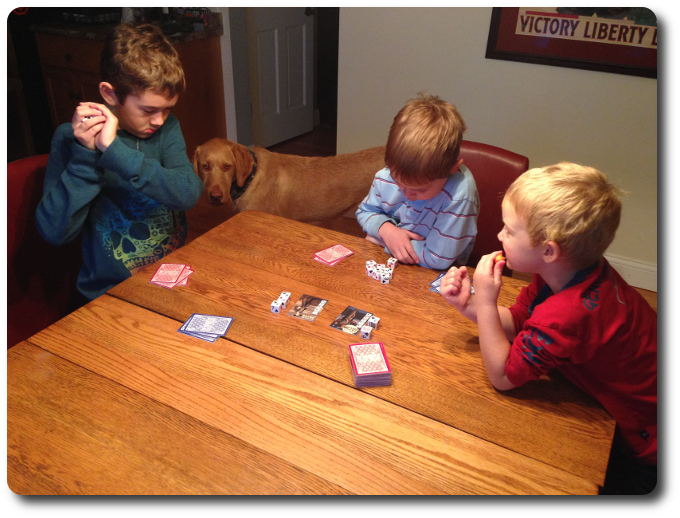
My two oldest shoot it out while my youngest waits to play the winner
The Parent Geeks also enjoyed the game, but on a different and slightly elevated intellectual level. According to one Parent Geek, “The real challenge here is keeping your cool, staying focused, and not letting the noise of the game distract you.” Another Parent Geek said, “I cannot believe how many different ways there are to play this game. What I like best is that each different variation of play is easy to learn and play after you understand the basic rules.” The only aspect of the game some of the Parent Geeks didn’t care for were the Action Shooter cards. According to one Parent Geek who thought the cards were unnecessary, “I understand what the cards are supposed to do, but I think they distract you from the game and kill the game’s pacing.” Despite the Action Shooter cards missing the mark with some of the Parent Geeks, all of the Parent Geeks agreed that 9-Shooter Quick Draw was an excellent game for casual players of all ages, awarding it their full approval.
The Gamer Geeks were not impressed with 9-Shooter Quick Draw. According to one Gamer Geek, “All I am doing is rolling and matching, rolling and matching, and rolling and matching. This game would put me to sleep if it weren’t for the fact it requires you to play the game really fast.” Another Gamer Geek said, “Because this game is so fast, there’s very little to think about other than just matching. It’s like a speed puzzle and I don’t much care for that.” And yet another Gamer Geek said, “Good theme, but boring games. Each game variant is so similar, I never felt like I was playing a different game. It was always just roll and go as fast as I could.” Finally, one Gamer Geek said, “If this game relied any heavier on luck, I would expect the game to come with a lucky horseshoe, a golden four leaf clover, and no less than 20 rabbit’s feet.” All the Gamer Geeks who played 9-Shooter Quick Draw thought the game was best left to the Parent Geeks and Child Geeks to enjoy.
Here’s the thing about 9-Shooter Quick Draw. In order to enjoy the game, you have to enjoy the feeling of being rushed. If you don’t, then the game will fail and frustrate. The game does empower the player to play the game at their own speed and in a manner that is most comfortable to them, but none of that matters if your opponent is going faster than you. But speed is not the only attribute that is necessary in this game. Players must have a high level of visual accuracy to quickly scan their dice and match the dice values with the card values. The best mix, based on what I have observed, is a steady pace that is quick and decisive. For example, my 7-year-old rolls the dice, looks at each die one at a time setting it aside when he is done with it, and then moves on to the next die. By the time he only has 3 dice left, he already knows what’s on the cards well enough to either get a hit or pick up all the dice to re-roll them. Good stuff.
The great and powerful equalizer throughout the game that keeps adults from destroying children (and vice versa) is luck. Speed, dexterity, and a fast mind are no good to any player if they don’t roll the right values.
As for me, 9-Shooter Quick Draw is an interesting game, but not one I would play a great deal. I think it’s perfect for quick games and game fillers, but the level of energy spent and the game play payoff does not match. I have to play the game a number of times in one sitting to feel satisfied with it when I walk away. Not the case for many of our players, however, and 9-Shooter Quick Draw proved to be a big hit with the younger players, casual players, and non-gamers. If you fall into one of these three groups, then pull up a chair, order yourself a stiff sarsaparilla, and join friends and family in a game of 9-Shooter Quick Draw. No need to bring your gun, but come ready for a fight all the same.
This is a paid for review of the game’s final prototype. Although our time and focus was financially compensated, our words are our own. We’d need at least 10 million dollars before we started saying what other people wanted. Such is the statuesque and legendary integrity of Father Geek which cannot be bought except by those who own their own private islands and small countries.



